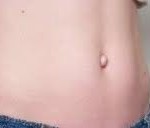The belly button goes by a variety of names including the navel and umbilicus. Whatever it is called, it is a very recognizeable anatomic structure and is the one scar that all humans share. But that centrally located scar can have a variety of shapes which fall into two main categories, an innie and an outie. Why one develops versus the other is purely coincidental and has nothing to do with how the umbilical cord is clamped at birth. Cord clamping is done several inches away from the navel and does not affect its eventual shape.
The outer belly button can be socially bothersome for some. Because the vast majority of the population has an inne, those that have an outie can feel it is unusual and abnormal. I have had more than one patient tell me that they felt stares and ridicule as a child or teenager. Some go to great lengths to keep covered. This may bring them to seek surgical change of this abdominal ‘malformation’. The number of women (and some men) seeking an umbilicoplasty procedure has been magnified by this era of navel beautification where piercings and tattooing have become popular. Humorously, on a website dedicated to the Top 25 Celebrity Bellybuttons, not a single outie appears amongst them.

The outie bellybutton in most cases is the result of this small hole persisting as the cut umbilical stump heals during birth. This allows a small stalk of peritoneal fat to protrude through resulting in an umbilical scar that heals with a dome due to the presence of this fat rather than an inversion. This is why you can push on an outie and make it go in, and then have it pop right back out. You are pushing this fat back inward and, sometimes if you push deep enough, you can even feel the fascial defect. Thus, every outie is in reality a ‘mini’ umbilical hernia. This also explains why a woman can have an inne which converts to an outie after pregnancy, the pressure of the intra-abdominal fetus unmasks the inherent fascial weakness at the base of the belly button.
In an outie umbilioplasty, the goal is an improved navel shape. The aesthetically attractive navel is one that is described as vertical, narrow, symmetric and with an upper hood in women. For men it is acceptable to just have a rounder inversion without a hood. The realistic goal in an umbilicoplasty is to make the inversion vertical and narrow.
The procedure can be done under either local or IV sedation anesthesia. The incision can be made either vertical through the skin dome or in a half-moon shape at its base. As soon as one goes through the skin, the protruding stalk of fat will be seen. Dissection is done around the stalk of fat to the surrounding rectus fascia. The fascial defect is isolated and the fat either amputated or pushed back inward. Several large sutures are placed across the fascial defect to approximate the fascial edges. Excess skin is then trimmed from the edges of umbilical skin and sutured down to the fascia with dermal sutures in a vertical fashion. This creates the innie shape. The skin edges now deep inside the new inne are then closed with running small dissolveable sutures. The new inner is then packed with Vaseline gauze and covered with a clear water-proof dressing. The entire umbiliplasty operation takes less than one hour.
Afterwards the only physical restriction is no working out that would stress the abdominal or stomach muscles for one month after surgery. The gauze dressing ore removed one week later. Patients report only mild discomfort in the first few days after surgery.
Converting an outie to an inne bellybutton employs the principle of a mini-umbilical hernia repair and inward skin plication as part of the umbilicoplasty. It is a very successful procedure that can help those patients feel more comfortable with the shape of this central abdominal region.
Dr. Barry Eppley
Indianapolis, Indiana


